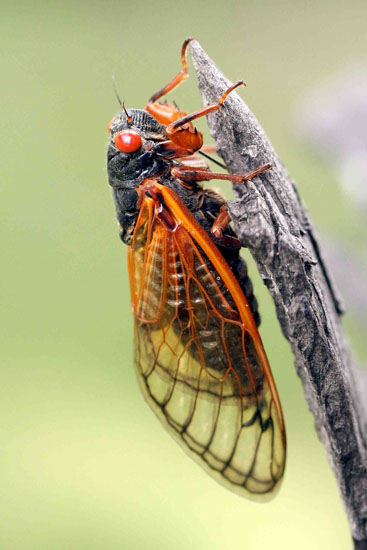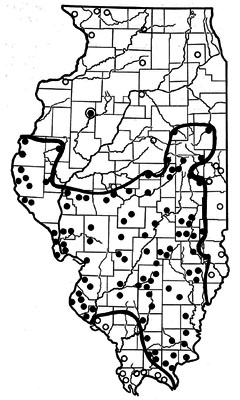Issue 18, October 22, 2010
Periodical Cicada
We are expecting an emergence of periodical cicada throughout much of the southern half of Illinois in May 2011. These insects cut slits in tree and shrub twigs, branches, and trunks that are less than one and one-half inches in diameter. This damage frequently causes flagging, the leaves beyond the injury die and turn brown, and weakens the stems enough to make them susceptible to snapping off during windy conditions. For this reason, we recommend against planting small diameter trees in the fall and spring preceding a major periodical cicada emergence.
Illinois Brood Emergence Dates for Periodical Cicada | ||
|---|---|---|
Year |
Brood |
Cycle |
2007 |
Northern Illinois Brood (Marlatt's XIII) |
17 |
2011 |
Great Southern Brood (Marlatt's XIX) |
13 |
2014 |
Iowan Brood (Marlatt's III) |
17 |
2015 |
Lower Mississippi River Valley Brood (Marlatt's XXIII) |
13 |
2020 |
Northern Illinois Sub-brood (part of Marlatt's XIII) |
17 |
2021 |
Great Eastern Brood (Marlatt's X) |
17 |
Brown, 1-inch-long nymphs emerge from the soil in late May, climb up the trunks of trees and other vertical objects, and grab onto the bark; adults emerge from a split made along the back. Adults harden and darken into 1-1/2-inch-long black insects with red eyes. They have clear wings with orange veins. Males sing to attract females, filling the air with a wonderful trill or obnoxious noise, depending on your attitude.

Periodical cicada adult on bark flake.
After mating, the female cicadas use their ovipositor, or egg-laying device, to slice several inch-long crevices in twigs and branches to lay their eggs. They prefer twigs and branches from about 1/4 to 1-1/2 inches in diameter. The leaves past this damage typically wilt and die, and the twigs and branches commonly snap off in the wind. Small transplanted trees, particularly fruit trees, commonly have a trunk diameter small enough that egg slits are made in the trunk, resulting in the tree snapping off.
Insecticide applications kill huge numbers of visiting cicadas, but analysis of egg-slit trunk damage shows little difference between treated and untreated research plots. The only way to protect small trees from serious damage in a heavy emergence area is to protect the trunk with screening or other material. This is expensive in materials and labor. It is much better to delay small-tree planting for a year or install larger stock, preferably those with a trunk diameter of at least 2-1/2 inches.
Emergence of periodical cicadas is not heavy in many areas, so tree planting can continue in those areas. These areas are very predictable. The memories of people living in particular areas during the 1998 emergence are very useful. Similarly, local newspaper accounts can be useful.

Periodical Cicada Great Southern Brood Map
Some thought about periodical cicadas and their needs can also help. Realize that these insects require a steady supply of sap-supplying tree and shrub roots for 13 years. Housing developments in which all trees and shrubs were removed prior to building will have few cicadas because the nymphs died when the trees were removed. Similarly, housing developments in areas that were originally farm fields or prairie will have few cicadas due to the lack of trees. The practice of bulldozing all trees off of a housing development site has been common only since the 1960s, so older housing developments probably will have large numbers of cicadas.--Phil Nixon
Author:
Phil Nixon